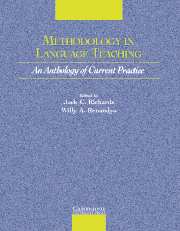Book contents
- Frontmatter
- Contents
- Acknowledgments
- Introduction
- Section I Approaches to Teaching
- Section 2 Lesson Planning and Classroom Management
- Section 3 Classroom Dynamics
- Section 4 Syllabus Design and Instructional Materials
- Section 5 Task and Project Work
- Section 6 Learning Strategies
- Section 7 Teaching Grammar
- Section 8 Teaching Pronunciation
- Section 9 Teaching Speaking
- Section 10 Teaching Listening
- Section 11 Teaching Vocabulary
- Section 12 Teaching Reading
- Section 13 Teaching Writing
- Section 14 Assessment
- Section 15 Technologies in the Classroom
- Chapter 36 Video in the ELT Classroom: The Role of the Teacher
- Chapter 37 The Internet for English Teaching: Guidelines for Teachers
- Chapter 38 What Can the World Wide Web Offer ESL Teachers?
- Section 16 Professional Development
- Credits
- Author Index
- Subject Index
- References
Chapter 36 - Video in the ELT Classroom: The Role of the Teacher
Published online by Cambridge University Press: 10 November 2010
- Frontmatter
- Contents
- Acknowledgments
- Introduction
- Section I Approaches to Teaching
- Section 2 Lesson Planning and Classroom Management
- Section 3 Classroom Dynamics
- Section 4 Syllabus Design and Instructional Materials
- Section 5 Task and Project Work
- Section 6 Learning Strategies
- Section 7 Teaching Grammar
- Section 8 Teaching Pronunciation
- Section 9 Teaching Speaking
- Section 10 Teaching Listening
- Section 11 Teaching Vocabulary
- Section 12 Teaching Reading
- Section 13 Teaching Writing
- Section 14 Assessment
- Section 15 Technologies in the Classroom
- Chapter 36 Video in the ELT Classroom: The Role of the Teacher
- Chapter 37 The Internet for English Teaching: Guidelines for Teachers
- Chapter 38 What Can the World Wide Web Offer ESL Teachers?
- Section 16 Professional Development
- Credits
- Author Index
- Subject Index
- References
Summary
INTRODUCTION
The teacher plays a key role in the success or failure of any video used in the language classroom. It is the teacher who selects the video, relates the video to students' needs, promotes active viewing, and integrates the video with other areas of the language curriculum. Any video's chances of achieving the important goals of motivating students' interest, providing realistic listening practice, stimulating language use, and heightening students' awareness of particular language points or other aspects of communication can be improved or destroyed by the way in which the teacher introduces the video and the activities which the students carry out in conjunction with viewing.
Video is an extremely dense medium, one which incorporates a wide variety of visual elements and a great range of audio experiences in addition to spoken language. This can be baffling for many students. The teacher is there to choose appropriate sequences, prepare the students for the viewing experience, focus the students' attention on the content, play and replay the video as needed, design or select viewing tasks, and follow up with suitable postviewing activities.
Published language teaching video materials usually provide guidance for teachers. Indeed, the most sophisticated of these are usually part of a multimedia package that, in addition to the videos themselves, includes viewing guides, student textbooks, teacher manuals, and audiocassettes.
Information
- Type
- Chapter
- Information
- Methodology in Language TeachingAn Anthology of Current Practice, pp. 364 - 367Publisher: Cambridge University PressPrint publication year: 2002
References
Accessibility standard: Unknown
Why this information is here
This section outlines the accessibility features of this content - including support for screen readers, full keyboard navigation and high-contrast display options. This may not be relevant for you.Accessibility Information
- 2
- Cited by
